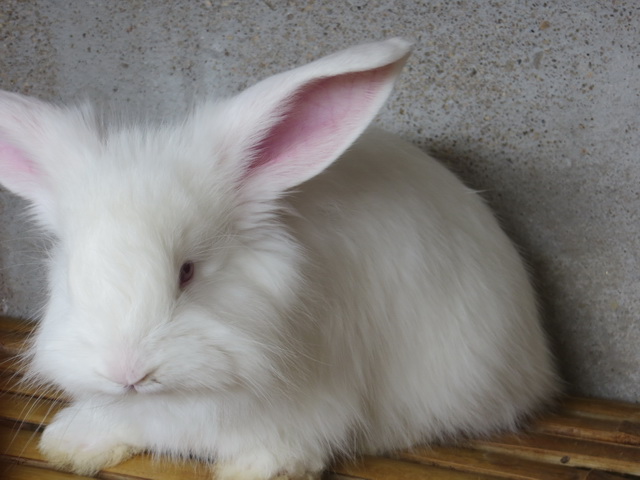1.長毛兔夜行性和嗜眠性
1. Night Travel and Sleepiness of Long Hair Rabbits
兔的原始祖先是野生穴兔。在大自然中�,它們常常被肉食獸、猛禽等動物傷害。為了生存,它們白天不敢露面,躲在洞穴之中,夜間才出洞覓食���。經過長期的自然選擇,形成了兔子的夜行性和嗜眠性。夜行性,就是指兔子從黃昏到清晨這段時間里,表現得十分活躍,采食、飲水也多于白天。兔夜里食入飼料和水的量占全部日糧和水的75%左右���。生產過程中需增加夜間飼喂。嗜眠性,就是指兔在白天吃飽喝足以后,很容易進人沉睡狀態。兔除保持一定程度的聽覺外,視覺消失,皮膚接受刺激后的反應也減弱或消失�����。生產上可以利用這一習性進行編耳號、注射、去勢或其他小型手術��。
The primitive ancestor of the rabbit is the wild cave rabbit. In nature, they are often injured by predators, raptors and other animals. In order to survive, they dare not appear in the daytime, hide in caves, and come out to feed at night. After a long period of natural selection, the nocturnal and sleepiness of rabbits were formed. Night travel means that rabbits are very active from dusk to early morning, and they eat and drink more water than during the day. The amount of feed and water consumed by rabbits at night accounts for about 75% of the total diet and water. Night feeding should be increased during the production process. Sleepiness refers to the fact that rabbits can easily fall asleep after having enough to eat and drink during the day. In addition to maintaining a certain degree of hearing, the rabbit's vision disappeared, and the response of the skin to stimulation also weakened or disappeared. This habit can be used in production for ear numbering, injection, castration or other minor operations.
2.長毛兔膽小,怕驚
2. Long-haired rabbits are timid and frightened.
兔表現得十分膽怯,特別是它的耳朵經常保持著高度的警惕性�����,一有異常聲響,兔子就會在籠內亂跳亂撞,用后足有力地踏籠底���,發出“啪啪”的響聲,并發出低沉的叫聲�����。這種現象對兔的健康有著不良的影響,輕則使兔掉膘�����、流產����,重則急性死亡����。
Rabbits show great timidity, especially their ears, which often maintain a high degree of vigilance. When there is an abnormal sound, the rabbit will jump and bump in the cage, tread on the bottom of the cage vigorously with hind feet, make a "crack" sound, and make a low cry. This phenomenon has a negative impact on the health of rabbits, which can cause fat loss, abortion and acute death.
3.長毛兔喜清潔干燥環境
3. Long-haired rabbits like clean and dry environment
兔臥在千凈的籠底上,常用舌頭舔其前肢和其他部位的被毛,以身上的污穢之物。兔的這種習性是它適應環境的本能,因為兔的抗病力很差,易感染病原微生物,不清潔和潮濕的環境,有利于病原微生物和寄生蟲的繁殖,增加兔患病的機會�。飼養兔很重要的一條原則�,就是要求環境干燥和清潔��。
Rabbits lie on the bottom of a clean cage, often licking their forelimbs and other parts of the coat with their tongues to remove dirt from their bodies. This habit of rabbits is its instinct to adapt to the environment, because rabbits have poor resistance to disease, are susceptible to infection of pathogenic microorganisms, unclean and humid environment, which is conducive to the reproduction of pathogenic microorganisms and parasites, and increase the chances of disease in rabbits. One of the most important principles in raising rabbits is to keep the environment dry and clean.
4.長毛兔耐寒怕熱
4. Cold and Fear Resistance of Long Hair Rabbits
兔體軀被毛濃厚,皮膚汗腺不發達,保暖性能好而散熱能力差,故能適應嚴寒而害怕炎熱�����。當環境溫度處于OC以下時,對兔影響不大;當環境溫度達到30^C 時,長毛兔采食量會減少,繁殖能力下降;溫度達到35'C 以上時,兔很容易中暑,甚死亡���。長毛兔生長繁殖更適宜的溫度是15~25C。但初生仔兔全身未長毛�����,防寒保暖是非常重要的�����。
Rabbits have thick coat, undeveloped sweat glands, good heat preservation and poor heat dissipation, so they can adapt to the cold and fear the heat. When the ambient temperature is below OC, it has little effect on rabbits; when the ambient temperature reaches 30 ^ C, the feed intake and reproductive capacity of long-haired rabbits will decrease; when the temperature reaches above 35'C, the rabbits are prone to heatstroke or even death. The optimum temperature for the growth and reproduction of long-haired rabbits is 15-25C. But the whole body of newborn rabbits is not hairy, so it is very important to keep warm and cold.
5.長毛兔同性好斗,群居性差
5. Long-haired rabbits are homosexual aggressive and poorly social.
長毛兔群居性差,不能像牛�、馬����、羊那樣集群放牧。群養長毛兔,尤其是成年同性公兔間常發生相互咬斗,有時咬得全身傷痕累累,失去種用價值���。為此,性成熟后的公兔務必單籠飼養,以免造成不必要的損失。
Long-haired rabbits are poorly populated and can not herd in groups like cattle, horses and sheep. Growing rabbits, especially adult homosexual rabbits, often bite each other, sometimes causing a lot of scars and loss of seed value. For this reason, male rabbits after sexual maturity must be raised in a single cage in order to avoid unnecessary losses.
6.長毛兔穴居性
6. Burrowability of Long Hair Rabbits
長毛兔穴居性是指兔有打洞穴居的習性��。這種習性也是其祖先下來的�,只要不加以限制,它就要挖掘地道,�����,在地下洞中繁殖產仔�����。對于籠養兔來說�,為順應這一習性,要在籠中給母兔設產仔箱,供兔產仔時用����。地面散養的兔,如果不控制其打洞,則會給飼養管理帶來不便。
The cave dwelling habits of long-haired rabbits refer to the cave dwelling habits of rabbits. This habit is also a legacy of its ancestors, as long as it is not restricted, it will dig tunnels, reproduction in underground caves. For caged rabbits, in order to adapt to this habit, we should set up a litter box for the female rabbits in the cage for the use of the rabbits. Rabbits raised freely on the ground will bring inconvenience to feeding and management if they do not control their burrowing.
7.長毛兔嚙齒行為
7. Rodenting Behavior of Long Hair Rabbits
成年長毛兔的牙齒共有28對�����。其中門齒3對:上頜2對����,下頜1對;前白齒5對:上領3對,下頜2對;后白齒6對:上�����、下頜均為3對�����。而門齒中的一對齒叫作恒齒,出生時即有,以后也不出現換牙現象,不斷地生長,兔必須通過經?��?幸в参飦砟Σ裂例X,以保持上下頜牙齒齒面的吻合。兔的嚙齒行為常常使兔籠和其他用具受到破壞�。因此,應經常在兔籠中投放一些帶葉的樹枝樹干����、普通的木質棍棒,供它采食和隨意啃咬磨牙�。
There are 28 pairs of teeth in adult rabbits. Three pairs of incisors: two pairs of maxilla and one pair of mandible; five pairs of anterior white teeth: three pairs of upper collar and two pairs of mandible; six pairs of posterior white teeth: three pairs of upper and lower jaws. The first pair of teeth in the incisor teeth is called permanent teeth. They are born and do not change teeth. They grow continuously. Rabbits must rub their teeth by biting hard objects regularly to keep the maxillary and mandibular teeth aligned. Rabbit rodent behavior often destroys rabbit cages and other appliances. Therefore, some leafy branches, trunks and common wooden sticks should be often put into the rabbit cage for feeding and gnawing molars at will.



 發布日期:2019-02-12
來源:http://guijingwen.cn 發布人:admin
發布日期:2019-02-12
來源:http://guijingwen.cn 發布人:admin